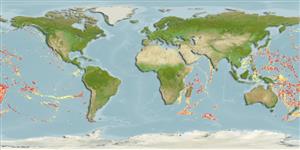Environment: milieu / climate zone / depth range / distribution range
البيئة
بحري قاعية المعيشة; نطاق العمق 320 - 2000 m (Ref. 51655). Deep-water
Indo-West Pacific: from Tanzania, Comoros, Madagascar, to Samoa, Moluccas, Marquesas and New Guinea (Ref 9788); north to Taiwan (Ref. 129007),
الحجم / وزن / العمر
Maturity: Lm ? range ? - ? cm
Max length : 13.0 cm TL ذكر/ مختلط الجنس; (Ref. 9788)
وصف مختصر
مفاتيح التعريف | الوصف الخارجي | قياسات المظهر الخارجي
الأشواك الظهرية (المجموع) : 6 - 9; الأشعة الظهرية الناعمة (المجموع) : 8 - 9; شوكة شرجية: 3 - 6; أشعه شرجية لينه: 7 - 8; فقرات: 30 - 32.
Mesopelagic, bathy-, and benthopelagic rare species, mostly occurring over continental and island slopes. Distinctive kasidoron larval and pre-juvenile stage in epipelagic waters. Zooplankton pickers, with small crustaceans in stomachs of both pre-juveniles and adults (Ref. 9788). The largest specimen collected from Taiwan (10.3 cm SL) is a mature female with two large ovaries containing many large, loose eggs (c. 0.6-0.7 mm); while three other specimens (9.72-10.1 and 10.07 cm SL) are mature males with well-developed testis (Ref. 129007).
Life cycle and mating behavior
النضج | التكاثر | وضع البيض | بيض | الخصوبة | Larvae
Paxton, J.R., 1999. Gibberichthyidae. Gibberfishes. p. 2203. In K.E. Carpenter and V.H. Niem (eds.) FAO species identification guide for fishery purposes. The living marine resources of the WCP. Vol. 4. Bony fishes part 2 (Mugilidae to Carangidae). FAO, Rome. (Ref. 9788)
IUCN Red List Status (Ref. 130435: Version 2024-2)
استخدامات بشرية
مصائد: غير ذات اهمية
أدوات
تقارير خاصة
Download XML
مصادر علي الأنترنت
Estimates based on models
Preferred temperature (Ref.
123201): 1.7 - 2.5, mean 2.1 °C (based on 25 cells).
Phylogenetic diversity index (Ref.
82804): PD
50 = 1.0000 [Uniqueness, from 0.5 = low to 2.0 = high].
Bayesian length-weight: a=0.01122 (0.00514 - 0.02450), b=3.04 (2.87 - 3.21), in cm total length, based on all LWR estimates for this body shape (Ref.
93245).
مستوى غذائي (Ref.
69278): 3.1 ±0.30 se; based on food items.
Fishing Vulnerability (Ref.
59153): Low vulnerability (10 of 100).
